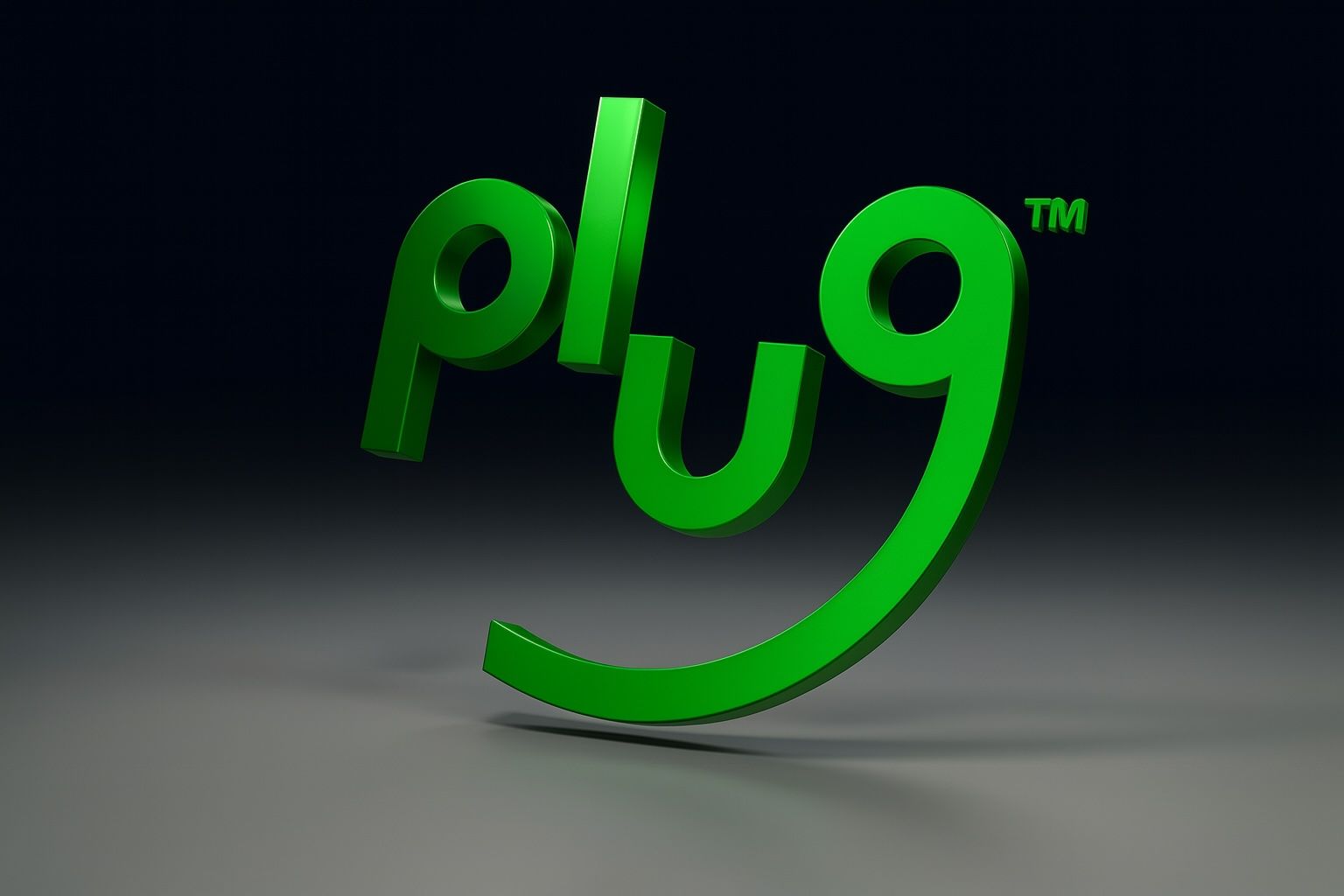- Plug Power stock’s roller-coaster October: Shares skyrocketed over +170% in the past three months amid hydrogen hype, touching a 52-week high above $4 by mid-October, before sliding back. As of October 22, 2025, PLUG trades around the low-$3 range after a sharp pullback [1] [2].
- Catalysts behind the surge: A wave of bullish analyst calls and big hydrogen project milestones ignited the rally. One firm doubled its price target to $7 – sparking a one-day +34% spike – as investors piled in and shorts scrambled to cover [3] [4]. Peers like Ballard Power jumped ~23% in sympathy, reflecting a sector-wide “hydrogen hype” halo [5].
- Financial boost vs. challenges: Plug Power raised $370 million in fresh cash via a warrant deal, easing near-term liquidity worries [6] [7]. Q2 revenue jumped 21% (to $174 million) and gross margins improved with aggressive cost cuts [8]. Yet the company remains unprofitable (net margin ≈ –293% last quarter) and continues to burn cash [9] [10], prompting dilution concerns and a cautious “hold” consensus on Wall Street [11] [12].
- Leadership shake-up & partnerships: Longtime CEO Andy Marsh will step down in 2026 after nearly 20 years at the helm. Successor José Luis Crespo – a key architect of Plug’s $8 billion sales pipeline with Amazon, Walmart, Home Depot – has been named incoming CEO [13] [14]. The company is expanding globally, delivering one of Europe’s largest green hydrogen plants (100 MW in Portugal) and securing new hydrogen supply contracts through 2030 [15] [16].
- Outlook divides experts: Optimists argue the hydrogen revolution is just getting started – one analyst predicts surging power costs and clean-energy policies will make green hydrogen “more competitive,” fueling further upside [17]. Skeptics counter that PLUG’s 170% spike may have run “too far, too fast,” with the average 1-year target (~$2.5) well below current prices [18] [19]. As Plug Power gears up for its next earnings report and a new CEO era, the stock’s fate hinges on turning hydrogen hype into a sustainable reality.
PLUG Stock Soars on Hydrogen Hype, Then Pulls Back
Plug Power Inc. (NASDAQ: PLUG) has been on a dizzying ride in recent weeks. The hydrogen fuel cell maker’s stock rallied from penny-stock levels over the summer to a peak around $4.18 by mid-October – a staggering rebound of roughly +170% in just three months [20]. At its 52-week high, PLUG was up about 65% year-to-date, ranking among 2025’s top-performing clean-energy stocks. The surge turned heads on Wall Street and online forums alike, as traders rushed in on the “green hydrogen” mania.
However, the euphoria cooled just as quickly. After closing at $3.40 on Monday, October 20, Plug’s stock plunged over 8% the next day, hitting an intraday low of $3.05 before ending around $3.12 on October 21 [21]. Profit-taking and nerves about the frenetic run-up set in, giving the chart a whiplash-inducing look. As of midday October 22, 2025, PLUG is hovering in the low-$3 range, roughly steady with yesterday’s close, as investors catch their breath and ask: Can this hydrogen rocket refuel for another rally, or is it running out of juice?
Catalysts: Analyst Upgrades and Hydrogen Hype Ignite a Rally
Several catalysts converged to launch Plug Power’s stock into the stratosphere this fall. A major spark came from Wall Street itself – analyst upgrades that dramatically boosted confidence in Plug’s future. The most eye-popping call arrived on October 3, when H.C. Wainwright analyst Amit Dayal more than doubled his 12-month price target from $3 to $7.00, the highest on the Street. Dayal reiterated a bullish “Buy” rating and argued that surging electricity costs (driven partly by data centers) plus new pro-clean-energy policies are making green hydrogen “more competitive” and economically attractive [22]. His bold call – well above where the stock was trading – “helped spark a feeding frenzy” among traders [23], with PLUG shares spiking 34.6% in a single day [24].
That was just the beginning. Over the following days, a flurry of brokers raised their targets and outlooks for Plug Power. TD Cowen bumped its target from $3.00 to $4.50 (Buy rating) after meetings with Plug’s CFO, citing a newly outlined “roadmap to profitability” built on cost cuts, scaling revenue, and smarter pricing [25]. Regional firm Craig-Hallum had just set a then-street-high $4.00 target in late September [26], a remarkable shift for a stock that traded near $2.30 at the end of September [27]. Even typically cautious analysts revised their views upward: Susquehanna’s Biju Perincheril nearly doubled his target to $3.50 (though he kept a Neutral rating) after Plug’s big financing move, acknowledging that the company’s improved cash position reduces worst-case downside [28]. In short, bulls piled in and bearish bets scrambled to get out of the way.
Indeed, Plug Power became a classic case of a short squeeze in early October. More than 30% of PLUG’s publicly traded float had been sold short (investors betting on a price drop) prior to the rally [29]. As positive news hit and the stock surged, many short-sellers rushed to cover their positions by buying back shares – ironically adding more fuel to the rally. Trading volumes exploded to 2–3× typical levels [30]. The rush of new buyers and panicked shorts sent Plug’s market value soaring far above its summer lows, and even peer fuel-cell stocks were lifted by the rising tide. For example, shares of Ballard Power Systems (BLDP) leapt roughly 23% in sympathy during Plug’s run – a halo effect from the hydrogen hype enveloping the sector [31].
Crucially, the rally wasn’t driven by speculation alone; real-world hydrogen milestones added fundamental weight to the story. In the first week of October, Plug Power delivered its first 10 MW industrial electrolyzer unit to Galp Energia’s refinery in Sines, Portugal – the initial piece of one of Europe’s largest green hydrogen plants (a planned 100 MW project) [32]. CEO Andy Marsh proclaimed this achievement proves “large-scale hydrogen is ready today” as a model for decarbonizing refineries [33]. Around the same time, Plug announced it extended a major hydrogen fuel supply agreement with a U.S. industrial gas partner through 2030, securing reliable, lower-cost hydrogen fuel for its network of fuel-cell customers [34]. These positive developments reinforced the narrative that Plug Power is executing on big projects and partnerships – not just riding on hype.
All told, October’s first half saw Plug Power stock vault from under $1.50 in early September to over $4.00 by mid-October [35]. The convergence of upbeat analyst endorsements, tangible project wins, and a favorable policy backdrop (more on that below) created a perfect storm for Plug’s shares. But as often happens with high-flyers, the faster they rise, the more volatile the ride can become – which brings us to the financial reality under the hood.
Financial Boost and Profitability Challenges
Behind Plug Power’s meteoric stock surge, the company has been shoring up its financial foundation – out of necessity. In early October, Plug executed a complex financing deal that immediately injected $370 million in cash into the company’s coffers [36]. In this deal, a large institutional investor agreed to exercise roughly 185 million existing warrants ahead of schedule at $2.00 per share, giving Plug a quick $370 M cash infusion [37]. In return, Plug Power issued the investor a new set of warrants (for an equivalent 185 M shares) with a much higher $7.75 strike price, exercisable by 2028 pending shareholder approval [38]. If those high-price warrants are fully exercised in the future, Plug could receive up to an additional $1.4 billion, providing a huge war chest for its growth plans [39].
This creative funding move significantly bolsters Plug’s liquidity at a critical time. The company ended Q2 2025 with only about $140 M in unrestricted cash [40] – barely a few months’ worth of its cash burn, raising concerns about a cash crunch. The $370 M injection extends Plug’s funding runway well into 2024 [41], giving management breathing room to execute its strategy. Susquehanna analysts noted that the deal “reduces worst-case downside” by easing near-term funding needs [42]. It’s no surprise, then, that Plug’s stock initially jumped on news of the financing, as it alleviated immediate liquidity fears.
However, this cash boost comes at a cost to existing shareholders: significant dilution. The warrant exercise added roughly 185 million new shares to Plug’s share count – about a 19% increase quarter-over-quarter [43]. And if the follow-on $7.75 warrants are eventually exercised, the total share count could roughly double from current levels [44]. This overhang of potential future shares has made some investors wary. In fact, Plug’s stock dipped ~10% right after the financing announcement, as the reality of possible dilution sank in [45]. One analyst cautioned that while the $2 warrant deal was “helpful for liquidity,” it also meant a large supply of shares could hit the market later, which “weighed on sentiment” [46]. In other words, Plug solved its cash problem but created a dilution dilemma – a balancing act not uncommon for growth-stage companies.
Meanwhile, Plug Power’s core financial performance remains a work in progress. In its most recent earnings (Q2 2025, reported August), Plug showed solid top-line growth but ongoing bottom-line losses. Revenue for Q2 was $173.97 million, up about 21% year-on-year, beating analyst expectations of ~$158 M [47]. A big contributor was Plug’s hydrogen electrolyzer sales (systems that produce hydrogen from water), which roughly tripled as new green hydrogen projects ramped up [48]. This indicates surging demand for Plug’s technology in the nascent hydrogen economy. The company also made headway on efficiency: under a cost-cutting program dubbed “Project Quantum Leap,” Plug slashed its cost of sales, improving gross margins from an abysmal –92% a year ago to about –31% in Q2 [49]. While still negative, that trajectory is a substantial improvement, suggesting Plug is starting to wring out manufacturing inefficiencies and scale benefits.
Yet, profitability remains elusive. Plug Power has never posted an annual profit in its decades-long history, and it continues to lose money each quarter [50]. In Q2, the firm lost about $0.16 per share (slightly worse than the expected $0.15 loss) [51] [52]. Plug’s net profit margin was around –293%, reflecting the reality that it spends nearly three dollars for every dollar of revenue [53]. The company’s operating expenses, factory build-outs, and hydrogen infrastructure investments are still far ahead of current revenues. Indeed, by standard metrics the stock looks expensive: even after the pullback, Plug’s market capitalization (around $3.6 billion) is roughly 20 times its annual revenue, a rich valuation that assumes significant growth ahead.
Wall Street analysts forecast continued net losses into 2026, though narrowing over time [54]. The consensus expects Plug will post about –$1.21 EPS for the current fiscal year [55], and only gradually improve thereafter. On a positive note, Plug’s management is aiming for a milestone of breakeven gross margins by Q4 2025 and to steadily improve cash flow by scaling up production and cutting costs [56]. Reaching that goal would mark a first step toward eventually breaking even at the operating level. But until the company proves it can approach profitability, many analysts and investors are cautious. As shown above, Plug’s recent rally has outpaced what traditional metrics would justify – making the stock’s next moves heavily dependent on delivering the growth and margin improvements that bulls are banking on.
New CEO at the Helm and Expanding Partnerships
Plug Power’s breakneck expansion is also prompting changes in its leadership and strategy execution. On October 7, the company announced that its long-serving CEO, Andy Marsh, will step aside after nearly 20 years in charge [57]. Marsh has been the face of Plug Power since 2008, overseeing its evolution from a niche fuel-cell maker to a vertically integrated hydrogen solutions provider. He will remain as CEO through the transition and then move to an Executive Chairman role in 2026 [58] [59]. The baton will be passed to José Luis Crespo, an insider who currently serves as Plug’s Chief Revenue Officer. Crespo will take over as company President this month and is slated to formally become CEO after the 2025 annual report (around March 2026) [60].
The market reaction to this planned succession was mixed. Plug’s stock initially dipped ~3% in pre-market trading on the announcement [61], reflecting some investor jitters whenever a long-time leader steps down. However, many see the transition as a natural evolution for a maturing company – and Crespo as a continuity candidate who can execute Plug’s aggressive growth plans. A 10-year veteran at Plug, Crespo joined in 2014 and has been credited with helping build a sales pipeline exceeding $8 billion, forging relationships with marquee customers like Amazon, Walmart, and Home Depot [62]. In other words, he’s been a key architect of Plug’s commercial strategy, especially in the material handling market where Plug’s hydrogen fuel-cell forklifts power warehouse fleets for retail giants. Analysts note that Crespo’s appointment signals stability and a focus on scaling up sales, rather than a dramatic strategic shift [63]. His insider knowledge of Plug’s operations and customers may enable a smoother ramp-up of new green hydrogen facilities and product lines already in the pipeline.
On the operations and partnership front, Plug Power has been moving swiftly to expand its global footprint. The company’s technology and services span the hydrogen value chain – from manufacturing electrolyzer units, to fueling infrastructure, to fuel-cell devices – and recent deals highlight that broad reach. In Europe, Plug delivered the first 10 MW electrolyzer to Galp’s Sines refinery in Portugal at the start of October [64], marking the first phase of a planned 100 MW green hydrogen plant. Once all ten 10 MW units are deployed, the Sines project will produce ~15,000 tons of green H₂ annually, helping cut over 110,000 tons of CO₂ emissions per year [65]. This is one of the largest hydrogen installations on the continent, essentially a proof-of-concept at scale that big oil refiners can integrate green hydrogen. Plug’s CEO Andy Marsh hailed it as evidence that “large-scale hydrogen is ready today” for industrial decarbonization [66]. Such projects not only generate revenue from equipment sales, but also potentially ongoing hydrogen supply and service contracts.
In Germany, Plug recently demonstrated its ability to supply and store hydrogen for energy projects. The company completed delivery of 44.5 metric tons of green hydrogen to the H2CAST pilot project – a cutting-edge hydrogen storage in salt caverns – between April and August 2025 [67]. After successfully meeting that commitment, Plug secured a follow-on contract to deliver an additional 35 tons of hydrogen to H2CAST [68]. Notably, the hydrogen was sourced from a partner electrolyzer (Hy2Gen’s ATLANTIS in Werlte, Germany) where Plug holds exclusive offtake rights [69], and transported using a fleet of 36 high-capacity trailers that Plug outfitted for the task. This kind of end-to-end execution – from production, to logistics, to storage integration – showcases Plug’s ambition to be a one-stop shop in the hydrogen ecosystem. It gives European customers confidence that green hydrogen fuel can be delivered reliably at scale, which could open the door to larger commercial orders.
Meanwhile, back in the U.S., Plug Power extended a major hydrogen supply partnership with an industrial gas company through 2030 [70]. Although the partner wasn’t named, the deal ensures Plug has a steady, low-cost supply of bulk hydrogen to fuel the thousands of fuel-cell forklifts and vehicles its customers operate (at Amazon distribution centers, Walmart warehouses, airports, etc.). This was a strategic win because hydrogen feedstock costs have been a pain point; locking in cheaper supply should help Plug improve its margins on fuel delivery contracts. Additionally, Plug continues to pursue new markets: earlier this year it announced plans for a massive 2 GW electrolyzer factory in Uzbekistan [71], part of a partnership to develop Central Asia’s green hydrogen capacity. All these moves signal that Plug Power is no longer just a niche U.S. player – it’s aiming for a global presence, positioning itself in key hydrogen hubs around the world.
Of course, competition is also heating up in the hydrogen and fuel cell arena. Plug’s longtime rivals like Ballard Power and FuelCell Energy are vying for many of the same project opportunities and investment dollars. So far, Plug’s aggressive expansion (and arguably first-mover advantages in some segments) has helped it outpace peers – as seen by its stock hugely outperforming many cleantech stocks in 2025. But as the industry grows, Plug will need to execute flawlessly to fend off competitors and justify its valuation. The incoming CEO Crespo’s mandate will be to turn these partnerships and projects into sustainable revenue growth and, eventually, profits – a challenge that has eluded Plug Power in the past.
Hydrogen Sector Tailwinds, Policy Boosts, and Risks
Plug Power’s recent rise comes against a backdrop of improving policy support and momentum for the hydrogen energy sector at large. Governments worldwide are increasingly betting that hydrogen will play a key role in the transition to clean energy, and they’re backing that bet with funding and incentives. In the United States, a new energy bill passed this fall extended a 30% investment tax credit for fuel-cell projects through 2032 and locked in a valuable production tax credit for clean hydrogen (up to $3 per kilogram) through 2028 [72]. These incentives sharply improve the economics for products like Plug’s fuel-cell power units and electrolyzers, effectively making hydrogen solutions more cost-competitive for end users. Plug Power stands to benefit directly – for example, its hydrogen forklift systems used in warehouses could qualify for the extended fuel-cell credits, and its planned hydrogen production plants will earn tax credits for every kilo of green hydrogen produced. Policy certainty for the next several years gives large customers and project developers confidence to proceed with hydrogen plans, creating a more favorable demand environment for Plug’s offerings.
Globally, big-ticket hydrogen projects are advancing as well, signaling a long-term growth runway. In the Asia-Pacific region, energy companies Woodside (Australia) and KEPCO (Japan) recently inked a deal to develop an Australia-to-Japan liquid hydrogen supply chain [73]. Europe and the Middle East have launched initiatives for “green hydrogen hubs” as part of their net-zero roadmaps. These developments point to a future where trillions of dollars could flow into hydrogen infrastructure over the coming decades – for production, transport, storage, and fuel-cell deployment. As one of the best-known pure-plays in this industry, Plug Power is strategically positioned to ride this “hydrogen economy” wave if it materializes. This macro enthusiasm has undoubtedly been a pillar of the bull case for Plug’s stock: investors are effectively valuing not just the company’s current business, but its potential slice of a much larger hydrogen energy market in the future.
That said, the hydrogen sector’s hype also carries risks. Some analysts have started cautioning that valuations across fuel-cell names have run ahead of fundamentals. After Plug’s 170% moonshot, research firm Clear Street Capital actually downgraded the stock to Hold, arguing it had run “too far, too fast” and citing a fair value near $3.50 [74]. And it’s not just Plug – even analysts covering peer companies have issued warnings of “early signs of over-exuberance” in the hydrogen space [75]. The excitement over hydrogen’s future has to be balanced against the current reality: fuel cell firms are still burning cash, grappling with high costs, and face competition from other clean tech like batteries. For instance, while Plug and others tout green hydrogen for long-haul trucking and industrial uses, battery-electric and other renewables are also racing to fill those roles. If hydrogen adoption rolls out slower than expected, these stocks could be vulnerable to steep corrections.
Investors in Plug Power should also brace for continued volatility. The stock’s beta is around 2.2 [76], meaning it tends to swing more than twice as violently as the overall market. This was evident in the wild price swings over just the past week. Part of this volatility comes from retail trading fervor – Plug has at times shown meme-stock-like behavior, with small investors on social media “chat forums” enthusiastically debating its prospects [77]. Options trading on PLUG hit unusually high volumes during the run-up [78], suggesting speculative bets contributed to the surge. Such momentum can reverse quickly, as seen on October 21 when sentiment soured and a wave of selling knocked the stock down 8% in one session [79]. The broader stock market’s tone (especially for high-growth tech and renewable energy shares) will likely influence Plug’s day-to-day moves as well. Any policy news, oil price swings, or clean-tech sector rotations could whipsaw these names.
Outlook: Can Plug Power Turn Hype into Lasting Gains?
Looking ahead, Plug Power’s future trajectory hinges on whether it can convert the recent hype and investments into tangible financial wins. In the near term, all eyes will be on Plug’s upcoming earnings report (expected in a few weeks) for Q3 2025. Investors are eager to see if the company can show continued revenue growth and further margin improvements. Notably, analysts at Oppenheimer, after touring Plug’s facilities last month, struck a hopeful tone – predicting that this next quarter could mark “the first meaningful step in [Plug’s] recovery” and that improving results might finally demonstrate Plug’s heavy investments “beginning to pay off” [80]. If Plug were to surprise the market with narrower losses or optimistic guidance (perhaps buoyed by that large sales pipeline), it could validate some of the recent bullishness and keep the stock momentum going.
On the other hand, expectations have now risen, and any disappointment could hit PLUG shares hard. The stock’s valuation implies aggressive growth and a path to profitability that is still mostly aspiration. Wall Street’s average 12-month price target remains only about $2.50 [81] – roughly 20–30% below the current price – reflecting caution from many analysts who see the stock as overextended relative to present fundamentals. Indeed, some top-tier firms remain skeptical: for example, Morgan Stanley reaffirmed an “underweight” rating on Plug recently with a low $1.50 target [82], essentially betting that the stock will retrace much of its recent gains. The range of forecasts is extremely wide (targets from as low as $1 up to that $7 high) [83], underscoring the uncertainty about Plug’s true value.
Expert opinions are starkly divided. Optimists believe that if Plug Power can execute – ramp up hydrogen fuel production, deliver on big projects, and continue cutting costs – the company could be at the forefront of a multi-decade energy transformation. They point to supportive government policies, a first-mover advantage in key niches (like hydrogen forklifts and electrolyzers), and partnerships with giants like Amazon that could scale dramatically. Some even speculate the stock’s recent surge might have more room to run; for instance, a Motley Fool analysis suggested PLUG “could soar 50% by 2026” if current growth trends persist [84]. Pessimists, however, emphasize that Plug has a long history of overpromising and underdelivering. They note that despite countless hydrogen “breakthrough” announcements over the years, Plug Power has yet to turn a profit, and the competitive landscape is intensifying. Bears worry that the company’s need to raise cash (as seen with the dilutive warrant deal) will be an ongoing issue, and that early adopters like Amazon could eventually seek alternatives or demand better economics as contracts evolve.
In the coming months, several signposts will indicate which narrative is winning out. First, execution on backlog – can Plug actually deliver the remaining 90 MW of that Portuguese project on time? How about scaling its new hydrogen plants in the U.S. to meet throughput and cost targets? Progress there would build credibility. Second, policy follow-through – the U.S. and other regions will need to implement their hydrogen subsidies smoothly, and projects must secure financing to break ground. Any hiccups in government support (or, conversely, new hydrogen incentives from the upcoming UN climate summit) could sway sentiment. Third, leadership transition – as Crespo takes the reins, watch for any shifts in strategy or financial discipline. Will he maintain the aggressive growth-at-all-costs approach, or focus more on operational efficiency to inch toward profitability?
For now, Plug Power’s story encapsulates both the excitement and the uncertainty of the clean energy revolution. The stock’s wild ride in 2025 – from a low of under $0.70 to over $4, and its recent volatile swings – highlights how investor sentiment can swing from euphoria to anxiety in a heartbeat [85] [86]. Hydrogen’s promise is huge: a future where trucks, factories, and even airplanes run on clean fuel from water. Plug Power has firmly positioned itself as a leader in this space, and its recent deals and development milestones give it a credible shot at that vision. But turning that vision into shareholder value is a marathon, not a sprint. As one cautious analyst put it, valuations already reflect a lot of future success, so any stumble could remind the market that revolutions don’t happen overnight [87].
Bottom line: Plug Power has captured lightning in a bottle with its stock rally, reminding investors of the dot-com-like upside (and risk) in clean tech. The next chapters – from earnings results to the CEO handoff – will be crucial tests of whether this hydrogen high-flier can support its lofty ambitions on solid ground, or if the gravity of financial reality will bring it back down to earth. For investors and onlookers, it’s a compelling drama unfolding in real time, with October 22, 2025 marking just another milestone in Plug Power’s turbulent journey toward the fuel of the future.
Sources: Financial markets data and analyst reports [88] [89]; company press releases and SEC filings; Reuters and Bloomberg news on Plug Power’s CEO transition and deals [90] [91]; TechStock² and MarketBeat analyses of PLUG’s price surge, short interest, and Wall Street ratings [92] [93]; U.S. Department of Energy policy updates; industry publications on global hydrogen projects [94].
References
1. ts2.tech, 2. www.marketbeat.com, 3. ts2.tech, 4. ts2.tech, 5. ts2.tech, 6. ts2.tech, 7. ts2.tech, 8. ts2.tech, 9. www.marketbeat.com, 10. www.marketbeat.com, 11. ts2.tech, 12. www.marketbeat.com, 13. ts2.tech, 14. www.reuters.com, 15. ts2.tech, 16. www.stocktitan.net, 17. ts2.tech, 18. ts2.tech, 19. ts2.tech, 20. ts2.tech, 21. www.marketbeat.com, 22. ts2.tech, 23. ts2.tech, 24. ts2.tech, 25. ts2.tech, 26. ts2.tech, 27. ts2.tech, 28. ts2.tech, 29. ts2.tech, 30. ts2.tech, 31. ts2.tech, 32. ts2.tech, 33. ts2.tech, 34. ts2.tech, 35. ts2.tech, 36. ts2.tech, 37. ts2.tech, 38. ts2.tech, 39. ts2.tech, 40. ts2.tech, 41. ts2.tech, 42. ts2.tech, 43. ts2.tech, 44. ts2.tech, 45. ts2.tech, 46. ts2.tech, 47. www.marketbeat.com, 48. ts2.tech, 49. ts2.tech, 50. ts2.tech, 51. ts2.tech, 52. www.marketbeat.com, 53. www.marketbeat.com, 54. ts2.tech, 55. www.marketbeat.com, 56. ts2.tech, 57. ts2.tech, 58. www.reuters.com, 59. www.reuters.com, 60. www.reuters.com, 61. www.reuters.com, 62. www.reuters.com, 63. ts2.tech, 64. ts2.tech, 65. ts2.tech, 66. ts2.tech, 67. www.stocktitan.net, 68. www.stocktitan.net, 69. www.stocktitan.net, 70. ts2.tech, 71. ts2.tech, 72. ts2.tech, 73. ts2.tech, 74. ts2.tech, 75. ts2.tech, 76. ts2.tech, 77. ts2.tech, 78. ts2.tech, 79. www.marketbeat.com, 80. ts2.tech, 81. ts2.tech, 82. www.marketbeat.com, 83. ts2.tech, 84. ts2.tech, 85. ts2.tech, 86. www.marketbeat.com, 87. ts2.tech, 88. ts2.tech, 89. www.marketbeat.com, 90. www.reuters.com, 91. ts2.tech, 92. ts2.tech, 93. ts2.tech, 94. ts2.tech








